新编语言学教程chapter 9课件
- 格式:ppt
- 大小:1.40 MB
- 文档页数:16
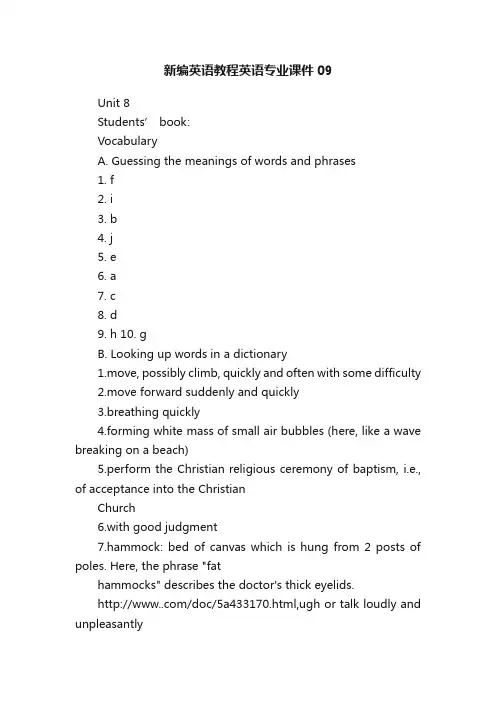
新编英语教程英语专业课件09Unit 8Students’ book:VocabularyA. Guessing the meanings of words and phrases1. f2. i3. b4. j5. e6. a7. c8. d9. h 10. gB. Looking up words in a dictionary1.move, possibly climb, quickly and often with some difficulty2.move forward suddenly and quickly3.breathing quickly4.forming white mass of small air bubbles (here, like a wave breaking on a beach)5.perform the Christian religious ceremony of baptism, i.e., of acceptance into the ChristianChurch6.with good judgment7.hammock: bed of canvas which is hung from 2 posts of poles. Here, the phrase "fathammocks" describes the doctor's thick eyelids./doc/5a433170.html,ugh or talk loudly and unpleasantly9.appearance, seeming likeness10.look with almost closed eyes11.thoughts of possible profits12.product of distillation (i.e., after heating liquid or steam) . Here, "the black distillate"refers back to "something infinitely black and evil" on line 43.Workbook:TEXT IComprehensionB. Reference version.1.The mothers had already learned the news before their sons could stammer it out.2.The news spread from one brush house to another and continued to travel fast into the town.3.When the doctor realized that Kino was the man who had asked for his help, he became bothserious (about the treatment) and wise/clever (about how he could gain).4.For a moment the doctor's eyes were focused on nothing as his thoughts turned to Paris.5.The news caused a profound "negative force" to be at work in the town. This could becompared to a scorpion, which causes pain, or the hunger created by the smell of food, or feeling of loneliness which comes when love is refused.6.What acted as the "venom-producing bag" of the town, i.e., the increasing self-interest in thetownspeople, began to create poison which afflicted the whole town with a negative force.TEXT IIComprehension1. F (This was not the reason. The reason is that gold had religious significance to them. KingTutankhamen, like other ancient Egyptians, worshipped gold and was buried in a gold coffin. )2. F (Copper and silver, for example, can do the same. )3. F (There must have been fierce competition, since "the only rule [at that time] was exercisedby the mob with a rope". )4. F (Wooden floors in some Italian jewellers' workshops may contain tiny flecks of gold. )5. T6. TTEXT IIIComprehension1. B2. A3. B4. C5. A6. CGUIDED WRITINGSentence CombinationReference version:Pearls are made by certain kinds of oysters, clams, and mussels, all of which are called molluscs. The pearl is actually composed of the material with which a mollusc coats an irritating particle that it cannot get rid of. This irritant may be a piece of broken shell, a parasite that has bored through the shell, or even a tiny grain of sand. The material the mollusc keeps layering ontothe particle to keep it from being an irritation is mother-0f-pearl. As many layers of mother-of-pearl are built up, a pearl is made. Natural pearls are found rarely, and large natural pearls even more rarely.However, people have discovered how to produce cultured pearls. To produce a cultured pearl, a smooth, round piece of mother-of-pearl is skillfully set into the living tissue of a pearl oyster. Then the oyster is returned to the water where it will stay for 3 to 5 years. The cultured pearls are less expensive than natural ones, but only an expert can tell the difference between them.Most of the oysters that are chosen for making cultured pearls are gathered on specially roughened netting lowered from rafts and the young oysters settle onto the netting.IV. Translation1.I really doubt if the treated drinking water will truly provide sufficient minerals that areessential to human health.2.As to how the splendid Maya Culture disappeared all of a sudden from the earth, it remains amystery hard to solve.3.When it was made plain that it was a big rat that had caused the breakdown of thetransmission system, we all felt relieved. Soon the system was brought to its normal operation.4.He was almost driven to despair when he learned that he was considered too old to take part inthe space voyage. He had spent three years preparing for this long-dreamed-of trip.5.The trip turned out to be a disaster, for the only means oftransport available in that area weredonkeys. We spend most of our time joggling on the backs of these animals, almost stifled by the heat and swirling dust.6.He was not a very popular professor among the students because he would invariably wanderoff his topic during the course of his lecture and drag the class into the time for break.7.The prominent collector declared that his collection included some invaluable paintings that11o one could afford to buy.8.To save the life of the little boy stung by a scorpion, the villagers used all the means and waysavailable to reduce the effect of poisoning.9.The annual Ice Sculpture Festival in this town attracted all manner of people from all over thecountry.10.Some countries were reduced to extreme poverty brought forth by war and natural disasters.For that matter, a U. N. official insisted that developed countries should take their responsibility to make new contributions to the economic development of the developing countries.B. Reference version:"Toot, toot, toot ..." The car swept on past the villages, and the inhabitants were puzzled. The mountain villages seldom had visitors. When it ,,as finally made plain who had come, the villagers, old and young, were all excited -- small boys scrambled and darted, shouting; old men followed, panting; young girls ran, giggling, all coming to see the car.Sensing the excitement, old Mack, the driver, now the ownerof a gold mine, felt proud. His eyes rolled up a little at the thought of his success.Twenty years ago he was a poor farmer. As a father of three children, he could hardly make both ends meet. When he heard of the gold in the north, his eyes had brightened and his fingertips burned a little. He decided to go and start a new life. Since he left the village, there had been different stories about him. Some said that he had died in a mine explosion. Now that he had come back as a gold mine owner, the villagers longed to know about his adventures.V. Blank FillingA. 1. on 2. in 3. off 4. out 5. up, up with 6. through 7. down 8. by9. away 10. in 11. on 12. out 13. up with 14. off 15. on16.acrossB. 1. content/satisfied 2. Thus/Therefore 3. subjects 4. preparation 5. be/talk 6. for7. to 8. California 9. migrants 10. search/hunt 11. possible 12. trips 13. conditions 14. which 15. for 16. articles 17. achieved/gained 18. awarded/given 19. highest 20. field/worldC.1. D2. B3. C4. A5. C6. D7. A8. B9. D 10. A 11. B 12. C 13. A 14. D 15. D(1) town of stone and plaster(2) were alike(3) aged(4) gave alms(5) give a semblance of(6) washed(7) foaming waves(8) take his place(9) related to(10) playing with(11) thoughtful look in his eyes(12) evil wish(13) stirred up(14) infinitely wicked(15) nobody ... as(16) stands in the way(17) rolled up(18) squinted(19) it was made plain(20) In despair(21) darted(22) panting(23) strangle out(24) All manner ofVI.1. A2. D3. A4. B6. B7. D8. D9. A 10.B 11. C 12. A 13. C 14. D 15.A 16.B 17. B 18. B 19. C 20. B 21. B 22. C。
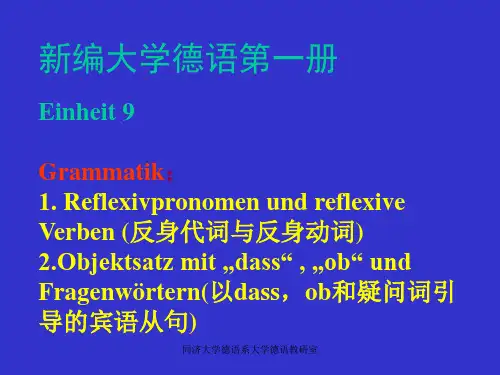
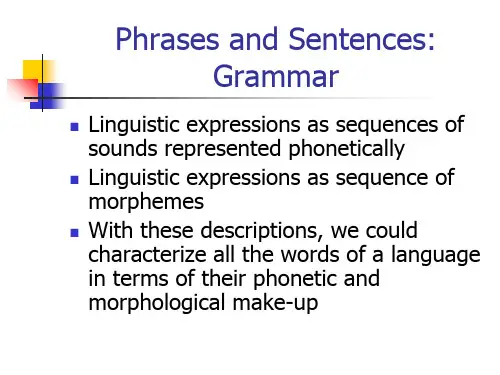

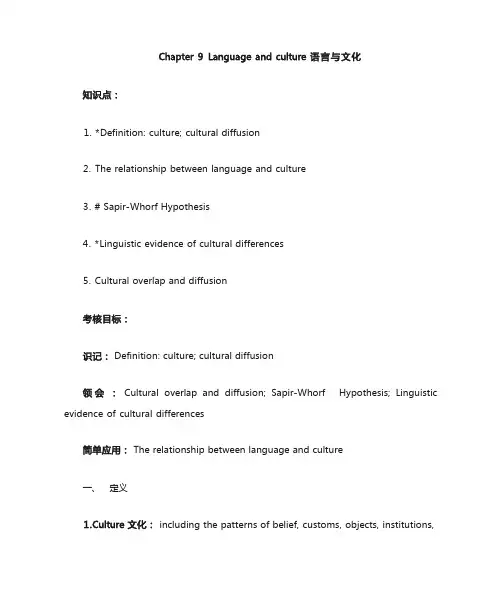
1. *Definition: culture; cultural diffusion2. The relationship between language and culture3. # Sapir-Whorf Hypothesis4. *Linguistic evidence of cultural differences5. Cultural overlap and diffusionDefinition: culture; cultural diffusionCultural overlap and diffusion; Sapir-Whorf Hypothesis; Linguisticevidence of cultural differencesThe relationship between language and culture一、定义including the patterns of belief, customs, objects, institutions,techniques, and language that characterizes the life of the human community. 由信仰,风俗,目标,机构,技术和语言构成,具有人类社区生活的特征。
through communication, some elements ofcultureA enter cultureB andbecomepartof cultureB. 通过交际, A 文化中的某些成分进入了 B 文化,并成为了 B 文化的一部分。
二、知识点techniques, and language that characterizes the life of the human community. 由信仰,风俗,目标,机构,技术和语言构成,具有人类社区生活的特征。
Twotypes of culture:1. material culture 物质文化: is concrete, substantial and observable. 具体的,实质的,可观察到的( e.g.意识文化、信念、价值观,时空概念)2. spiritual culture 精神文化: is abstract, implicit, and hidden. 抽象的,多义的,不可见的。
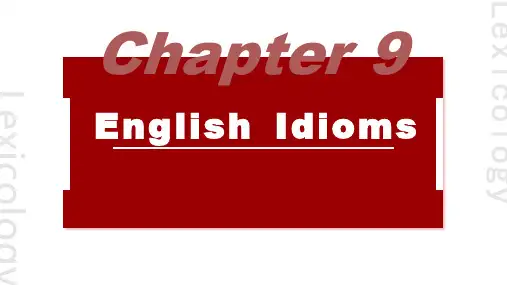
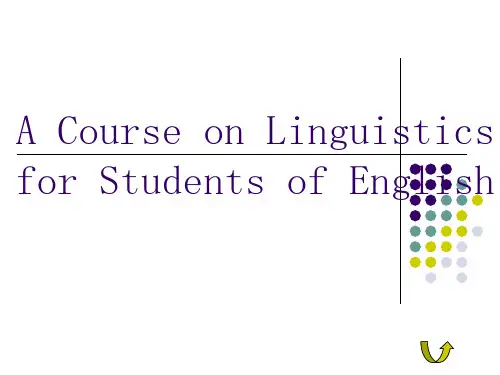
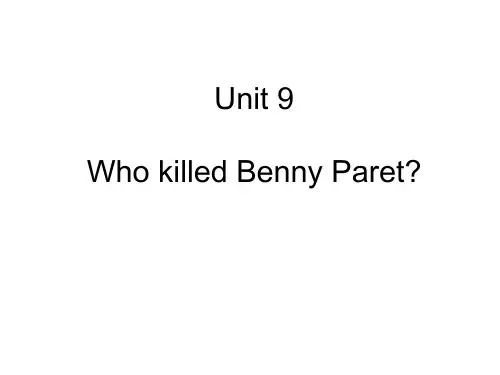

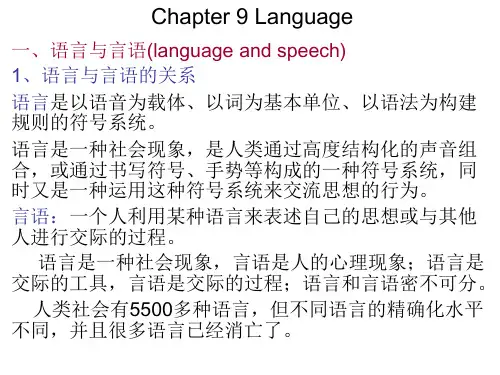
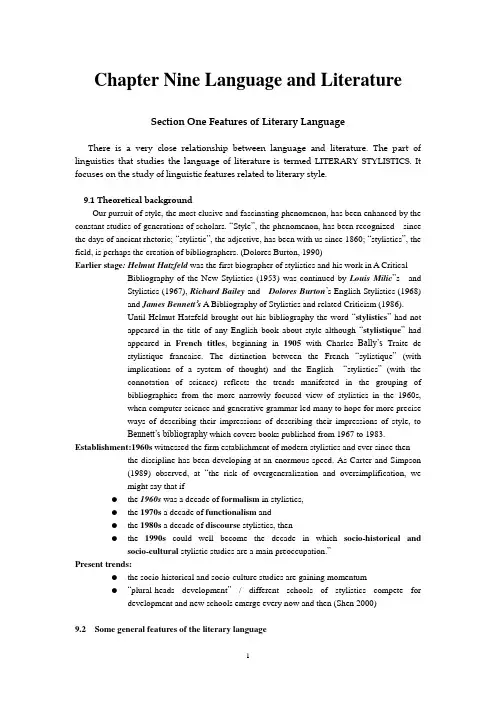
Chapter Nine Language and LiteratureSection One Features of Literary LanguageThere is a very close relationship between language and literature. The part of linguistics that studies the language of literature is termed LITERARY STYLISTICS. It focuses on the study of linguistic features related to literary style.9.1 Theoretical backgroundOur pursuit of style, the most elusive and fascinating phenomenon, has been enhanced by the constant studies of generations of scholars. “Style”, the phenomenon, has been recognized since the days of ancient rhetoric; “stylistic”, the adjective, has been with us since 1860; “stylistics”, the field, is perhaps the creation of bibliographers. (Dolores Burton, 1990)Earlier stage: Helmut Hatzfeld was the first biographer of stylistics and his work in A Critical Bibliography of the New Stylistics (1953) was continued by Louis Milic”s andStylistics (1967), Richard Bailey and Dolores Burton’s English Stylistics (1968)and James Bennett’s A Bibliography of Stylistics and related Criticism (1986).Until Helmut Hatzfeld brought out his bibliography the word “stylistics” had notappeared in the title of any English book about style although “stylistique”hadappeared in French titles, beginning in 1905with Charles Bally’s Traite destylistique francaise. The distinction between the French “sylistique”(withimplications of a system of thought) and the English “stylistics”(with theconnotation of science) reflects the trends manifested in the grouping ofbibliographies from the more narrowly focused view of stylistics in the 1960s,when computer science and generative grammar led many to hope for more preciseways of describing their impressions of describing their impressions of style, toBennett’s bibliography which covers books published from 1967 to 1983. Establishment:1960s witnessed the firm establishment of modern stylistics and ever since then the discipline has been developing at an enormous speed. As Carter and Simpson(1989) observed, at “the risk of overgeneralization and oversimplification, wemight say that ifthe 1960s was a decade of formalism in stylistics,the 1970s a decade of functionalism andthe 1980s a decade of discourse stylistics, thenthe 1990s could well become the decade in which socio-historical and socio-cultural stylistic studies are a main preoccupation.”Present trends:the socio-historical and socio-culture studies are gaining momentum“plural-heads development”/ different schools of stylistics compete for development and new schools emerge every now and then (Shen 2000)9.2 Some general features of the literary languageWhat seems to distinguish literary from non-literary usage may be the extent to which the phonological, grammatical and semantic features of the language are salient, or foregrounded in some way. The phonological aspect will be outlined in the next section. In this section, we shall briefly discuss the grammatical and semantic aspects.9.2.1 Foregrounding and grammatical formIn literary texts, the grammatical system of the language is often made to “deviate from other, more everyday, forms of language, and as a result creates interesting new patterns in form and in meaning” (Mularovsky) by means of the use of non-conventional structures that seem to break the rules of grammar.Ex. 9—1 The 1960 dream of high rise living soon turned into a nightmare.In this sentence, there is nothing grammatically unusual or “deviant” in the way the words of the sentence are put together. However, in the following verse from a poem, the grammatical structure seems to be much more challenging, and makes more demands on our interpretative processing of these lines:Ex. 9—2 Four storeys have no windows left to smashBut in the fifth a chipped sill buttressesMother and daughter the last mistressesOf that black block condemned to stand, not crash.Ex. 9-3The red-haired woman, smiling, waving to the disappearing shore. She left the maharajah; she left innumerable other lights o’passing love in towns and cities andtheatres and railway stations all over the world. But Melchior she did not leave.9.2.2 Literal language and figurative languageLITERAL meaning: The first meaning for a word that a dictionary definition gives.E.g. tree: “a large plant”, an organism which has bark, branches and leaves.FIGURATIVE meaning: the metaphorical meaning rather than the ordinary one.E.g. a family tree, (ancestry)Different forms of tropes (figurative use of language):SIMILE is a way of comparing one thing with another, of explaining what one thing is like by showing how it is similar to another thing, and it explicitly signals itself in a text,with the words as or like.METAPHOR, like a simile, also makes a comparison between two unlike elements; but unlike a simile, this comparison is implied rather than stated. Compare the followingtwo examples.Ex. 9—6 The world is like a stage. (simile). Ex. 9—7 All the world’s astage,Metonymy: like metaphor(the transport of ideas), means a change of name.Synecdoche: refers to using the name of part of an object to talk about the whole thing, and vice versa.9.2.3 The analysis of literary languageVarious ways can be used to literary texts, depending on:the kind of text we are dealing withthe aim of analysis (cf. P288-289 for detailed procedures)Section Two The Language in Poetry9.3 The language in poetry9.3.1 Sound patterningMost people are familiar with the idea of RHYME in poetry, in deed for some, this is what defines poetry. END RHYME(i.e. rhyme at the end of lines, cVC) is very common in some poetic styles, and particularly in children’s poetry:9.3.2 Different forms of sound patterningRhyme me-be love-prove/mi:/-/bi:/ /l v/-/pruv/Alliteration: the initial consonants are identical (Cvc)me-my pleasures-prove/mi:/-/mai/ /’ple z/ / pruv/Assonance(准押韵) describes syllables with a common vowel (cVc)live-with-will come-love/liv/-/wi /-/wil/ /k m/-l v/Consonance(辅音韵): Syllables ending with the same consonants (cvC)will-all/wil/- :l/Reverse rhyme(反韵)describes syllables sharing the vowel and initial consonant, CVc, rather than the vowel and the final consonant as is the case in rhyme.with-will/wi /-wil/Pararhyme(侧押韵)two syllables have the same initial and final consonants, but different vowels (CvC)live-love/l v/-l v/Repetition CVC, for example “the sea, the sea”. This is called REPETITION.9.3.3 Stress and metrical patterningIn English words of two syllables, one is usually uttered slightly louder, higher, held for slightly longer, or otherwise uttered slightly more forcefully than the other syllable in the same word, when the word is said in normal circumstances. This syllable is called the STRESSED syllable. For example, in the word kitten, kit is the stressed syllable, while ten is the UNSTRESSED syllable. In addition to stress within an individual word, when we put words together in utterances we stress some more strongly than others. Where someone puts the stress depends partly on what they think is the most important information in their utterance, and partly on the inherent stresses in the words.Metrical pattern : (韵律模式)1.Iamb(抑扬格): the pattern of unstressed and stressed syllables2.Trochee (扬抑格): the stressed followed by an unstressed syllables3.Anapest : two unstressed syllables followed by a stressed one4.Dactyl: a stressed syllable followed by two unstressed ones.5.Spondee: two stressed ( lines of poetry rarely consist only of spondees)6.Pyrrhic: two unstressed syllable9.3.4 Conventional forms of metre and soundAt different times, different patterns of metre and sound have developed and become accepted as ways of structuring poems. These conventional structures often have names, and if you are analyzing poems, it is advisable to be familiar with the more frequent conventions that poets use. Some conventional forms of metre and sound are as follows. (see P294-295)CoupletsQuatrainsBlank verseOthers: sonnet, free verse, limericks.9.3.5 The poetic functions of sound and metre9.3.6 How to analyse poetry?The following checklist provided by Thornborrow and Wareing (1998) may help to cover the areas of discussion when analyzing poetry.(1)Information about the poemIf this information is available to you, somewhere in your analysis give the title of the poem, the name of the poet, the period in which the poem was written, the genre to which the poem belongs, e.g. lyric, dramatic, epic sonnet, or satire, etc. You might also mention the topic, e.g. whether it is a love poem, a war poem or a nature poem.(2)The way the poem is structuredThese are structural features that you should check for; there may well be others we have omitted. Don’t worry if you don’t find any examples of reverse rhyme, or a regular metrical pattern in your poem. What matters is that you looked, so if they had been there, you wouldn’t have missed them.Section Three Language in Fiction9.4. The language in fiction9.4.1 Fictional prose and point of viewAccording to Mick short (1996), we need at least three levels of discourse to account for the language of fictional process (i.e. a novel or short story), because there is a narrator-narratee level intervening between the character-character level and the author-reader level (see P298): ViewpointsI-narrators:3rd-person narratorsschema-oriented languagegiven vs new informationDeixis9.4.2 Speech and thought presentationSpeech presentation: (see P301-303)1)Direct speech (DS)2)Indirect Speech (IS)3)Narrator’s representation of speech acts (NRSA)4)Narrator’s representation of speech (NRS)The speech contribution of the character is arranged in a decreased orderThough presentation (see P301-304)1)Direct thought2)Free indirect thought3)Stream of consciousness writing9.4.3 Prose style (P306-307)1)authorical style:2)text style.Section Four Language in Drama9.5 The language in dramaA play exists in two ways—on the page, and on the stage. Our interest in this book, nevertheless, is in the language of the play on the page.9.5.1 How should we analyse drama?a)Drama as poetryb)Drama as fictionc)Drama as conversation9.5.2 Analysing dramatic language1)Turn quanjtity and length2)Exchange sequence3)Production errors4)The cooperative principle5)Status marked through language6)Register7)Speech and silence-female characters in plays9.5.3 How to analyse dramatic texts?1)Paraphrase the text—i.e. put it into your own words2)Write a commentary on the text3)Select a theoretical approach, perhaps from those discussed above.Chapter 11 Language and Foreign Language TeachingSection One Linguistic Views in Language1. The relation of linguistics to TEFL语言学和外语教学的关系Language is viewed as a system of forms in linguistics, but it is regarded as a set of skills in the field of language teaching. Linguistic research is concerned with the establishment of theories, which explains the phenomena of language, whereas language teaching aims at th e learner’s mastery of language.To bride the gap between the theories of linguistics and the practice of foreign language teaching, APPLIED LIGUISTICS serves as a mediating area that interprets the results of linguistic theories and makes them user-friendly to the language teacher and learner.Applied linguistics is conducive to foreign language teaching in two major aspects:1)Firstly, applied linguistics extends theoretical linguistics in the directionof language learning and teaching, so that the teacher is enabled to make better decisions on the goal and content of the teaching.2)Secondly, applied linguistics states the insights and implications thatlinguistic theories have on the language teaching methodology.2. Various linguistic views and their significance in language learning and teaching语言学观点及其在语言教学中的价值2.1 Traditional grammar传统语法A TRADITIONAL GRAMMAR is a pre-20th century language description, which is based on earlier grammars of Greek or Latin. As a product of the pre-linguistic era, it lays emphasis on correctness, literary excellence, the use of Latin models, and the priority of the written language.In language teaching textbooks based on traditional grammars take prominent writers of the previous centuries as language models. They favor the pasty “purest” language form rather than the present “degenerated” from; they prefer the written language to spoken language; they concentrate on detailed points instead of the construction of the whole text. Under traditional language teaching, students learn to know many taboos. For example, in English one cannot use “Split infinitives” or end sentences with prepositions,because these are not allowed in Latin grammar. The traditional approach to language teaching involves the presentation of numerous definitions, rules and explanations, and it adopts a teacher-centered grammar-translation method, i.e. the main teaching and learning activities are grammar and translation study. In the view of many modern linguists, such an approach is damaging to language learning. They argue that one should teach the language, not teach about the language. In communication, one should learn first to “speak” the language, not to “read” the language.2.2 Struicturalist linguistics结构主义语言学Structuralist linguistics describes linguistic features in terms of systems or structures. Dissatisfied with traditional grammars, structuralist grammar sets out to describe the current spoken language which people use in communication. For the first time, structuralist grammar provides description of phonological systems, which aids the systematic teaching of pronunciation. However, like traditional grammars, the focus of structuralist grammar is still on the grammatical structures of a language. Structuralist teaching materials are arranged on a basis of underlying grammatical patterns and structures, and ordered in a way supposed to be suitable for teaching. Structuralist linguists are influenced by the behaviouristic view that one learns a language by building up habits on the basis of stimulus-response chains. In teaching method this implies a pattern drill technique which aims at the learner’s automatism’s for language forms.2.3 Transformational-Generative linguistics转换生成语言学Proposed by Chomsky, Transformation-Generative grammar (or TG grammar) sees language as a system of innate rules. In Chomsky’s view, a native speaker possesses a kind of linguistic competence. The child is born with knowledge of some linguistic universals. While acquiring his mother tongue, he compares his innate language system with that of his native language and modifies his grammar. Therefore, language learning is not a matter of habit formation, but an activity of building and testing hypothesis. As for the construct of a sentence, TG grammar describes it as composed of a deep structure, a surface structure and some transformational rules. Although Chomsky does intend to make his model a representation of performance, that is, the way language is actually used in communication, some applied linguists find that TG grammar offers useful ideas for language teaching. In designing teaching materials, for example, sentence patterns withthe same deep structure can be closely related, such as the active and the passive. Transformational rules may assist the teacher in the teaching of complex sentence construction. In the teaching of literature, TG grammar provides a new instrument for stylistic analysis. For instance, a writer’s style can be identified according to certain kinds of transformation which frequently appear in his writing, say, nonimalization, verbalization, adjectivization, adverbialization, passivization, etc. (Ohmann, 1964). Nevertheless, despite the various attempts to apply TG grammar to language teaching, the influence of such a formal and abstract grammar remains limited in the field of language education as Chomsky himself openly claimed that language teaching and learning is not his concern.2.4 Functional linguistics功能语言学Taking a semantic-sociolinguistic approach, Halliday’s systemic functional linguistics sees language as an instrument used to perform various functions in social interaction. Halliday writes a number of works in which he examines the development of language functions in the child and the function language has in society.For Halliday, learning language is learning to mean. In other to be able to mean, one has to master a set of language functions, which have direct relation to sentence forms. In the child language, there are seven initial forms. In the adult language, however, these discrete functions are replaced by three META-FUNCTIONS: the ideational function, the interpersonal function, the ideational function, and the textual function.Since systemic-functional linguistics sees the formal system of language as a realization of functions of language in use, its scope is broader than that of formal linguistic theories. In the field of language teaching, it leads to the development of notion / function-based syllabuses, which have attracted increasing attention. In the section of “syllabus design,” we will come back to this kind of syllabus in detail.2.5 The theory of communicative competence交际能力理论The concept COMPETENCE originally comes from Chomsky. It refers to the grammatical knowledge of the ideal language user and has nothing to do with the actual use of language in concrete situations. This concept of linguistic competence has been criticized for being too narrow and resenting a “Garden of Eden View”. To expand the concept of competence, D.H. Hymes (1971) proposes COMMUNICATIVE COMPETENCE, which has fourcomponents: POSSIBILITY –the ability to produce grammatical sentences; FEASIBILITY—the ability to produce sentences which can be decoded by the human brain; APPROPRIATENESS—the ability to use correct forms of language in a specific socio-cultural context; PERFORMANCE—the fact that the utterance is completed.In Hymes’ view, the learner acquires knowledge of sentences not only as grammatical but also as appropriate. The aim of language learning is the ability to perform a repertoire of speech acts so as to take part in speech events. This is another way of saying that learning language is learning to perform certain functions. Like Halliday’s functional grammar, Hymes’ theory also leads to notion / function-based syllabuses, and a step further, communicative syllabuses.The theory of communicative competence stresses the context in which an utterance occurs. In its application, the teacher may teach how in different situations the same sentence can perform the function of statement, command, or request. On the other hand, while introducing different linguistic forms with the same semantic structure, for example the two forms of “you” in Chinese, he may draw special attention to different contexts in which they are used. The conceptual approach also leads to a concentration on discourse, in Hymes’ term linguistic routines—the sequential organization beyond sentences. Thus in the teaching of literature, the teacher can focus on features of different generes. In the teaching of conversation, he can introduce such strategies as opening, continuing, turn taking and closing. To present teaching contents of this kind, a learner-centered teaching methodology is necessary.Section Two Syllabus Design3. Syllabus Design教学大纲的设计3.1 What is syllabus?什么是教学大纲SYLLABUS is the planning of a course of instruction. It is a description of the course content, teaching procedures and learning experiences. The concept “syllabus” is often used interchangeably with “curriculum”, but CURRICULUM is also used in a broader sense, referring to all the learning goals, objectives, contents, processes, resources and means of evaluation planned for students both in and out of the school.3.2 Major factors in syllabus design大纲设计的主要因素1)Selecting participants选择参与者2)Process过程3)Evaluation评估3. Types of Syllabus教学大纲的类型Structural syllabus结构教学大纲Influenced by structuralist linguistics, the STRUCTURAL SYLLABUS is a grammar oriented syllabus based on a selection of language items and structures. The vocabulary and grammatical rules included in the teaching materials are carefully ordered according to factors such as frequency, complexity and usefulness. The linguistic units in a sentence may appear in slots:Situational syllabus情景教学大纲The SITUATONAL SYLLABUS does not have a strong linguistic basis, yet it can be assumed that the situationnalists accept the view that language is used for communication. The aim of the situational syllabus is specifying the situations in which the target language is used. The selection and organization of language items are based on situations. Grammatical forms and sentence partner are introduced and practiced, but they are knitted in dialogues entitled “At the Air-port”, “At the Supermarket”, “At the Bank”, and so on. In class an AURAL-ORAL TEACHING METHOD is adopted, i.e., new materials are heard and spoken before they are read and written by the learners. This method may still be teacher-centred, but compared with the grammar-translation method there is more particip ation on the learner’s part. The teacher can make use of picture, real objects, and the postures of the participants to involve students in dialogues and role-playing.Notional-functional syllabus意念-功能教学大纲First proposed by D. Wilkins and J.A. van Ek, the NOTIONAL-FUNCTIONAL SYLLABUS has received considerable attention since the 70s. Compared to the situational syllabus, the notional-functional syllabus has a much stronger theoretical basis—it is directly influenced by Halliday’s functional grammar and Hymes’ theory of communicative competence. The concept of NOTION refers to the meaning one wants to convey, while that of FUNCTION refers to what one can do with the language. For example, while sayi ng “Would you please tell me how to get to the library?” the speaker expresses the notion of inquiry and performs the function of asking the way. The notional-functional syllabus is initiallyconcerned with what the learner communicates through the language—not with what the grammatical structure is, or when or where he uses the language. It is proposed that one should analyze the needs of the learner to express meanings before deciding the lexico-grammatical options required. What the notional-functional syllabus wants the learner to acquire is, first, the knowledge of language structures, and second, the ability of using them in different situations to express ideas. The notional-functional approach to language teaching views all course components as a systematic whole, and classroom activities should be learner-centred.Communicative syllabus交际教学大纲A COMMUNICATIVE SYLLABUS aims at the learner’s communicative competence. Based on as notional-functional syllabus, it teaches the language needed to express and understand different kinds of functions, and emphasizes the process of communication.Summarizing the previous theories on communicative approach to syllabus design, Janice Yalden (1983) lists ten components of a communicative syllabus:1. as detailed a consideration as possible of the purposes for which the learners wish to acquire the target language;2. some idea of the setting in which t hey will want to use the target language (physical aspects need to be considered, as well as social setting);3. the socially defined role the learners will assume in the target language, as well as the roles of their interlocutors;4. The communicative events in which the learners will participate: everyday situations, vocational or professional situations, academic situations, and so on;5. the language functions involved in these events, or what the learner will need to be able to do with or through the language;6. the notions involved, or that the learner will need to be able to talk about;7. the skills involved in the “knitting together” of discourse: discourse and rhetorical skills;8. the variety or varieties of the target language that will be needed, and the levels in the spoken and written language which the learners will need to reach;9. the grammatical content that will be needed;10. the lexical content that will be needed.Fully Communicative Syllabus完全交际教学大纲The FULLY COMMUNICATIVE SYLLABUS stresses that linguistic competence is only a part of communicative competence. If we focus on communicative skills, most areas of linguistic competence will be developed naturally. Therefore, what we should teach is communication through language rather than language for communication. It is suggested that fully communicative teaching should do away with well planned syllabuses. What should be decided is the problem of communication to be solved, and the teacher should involve his students into activities in which they imitate his use of language consciously or unconsciously. If the teacher can well direct this process, language learning will take care of itself.Section Three Language Learning and Error Analysis4. Language learning语言学习The previous sections summarized various linguistic views and their significance in language teaching and learning. The discussions centred around how the practice of language teaching and learning has been influenced by different schools of linguistic studies, e.g. traditional grammars, structuralist linguistics, transformational generative lingui9stics, functional linguistics, etc. Although “learning” has frequently mentioned, most of the discussions are actually about how “teaching” has been influenced by linguistic theories. It is true that language teachers’ knowledge in linguistics (or their linguistic views) plays an important role when they make decisions about what to teach and how to teach. However, in whatever circumstances, in order for language teaching to be effective, no decision should be made if due attention is not paid to what and how the learners actually learn. In fact, in the past three or four decades, the research focus in language education has shifted from “how teachers teach” to “how learners learn”.4.1 Grammar and language learning语法和语言学习One of the major issues raised by second language acquisition researchers is the controversial question of whether and how to include grammar in second language instruction. The discrete-point grammar instruction conducted by more traditional language teachers has been widely criticized for focusing on forms and ignoring meanings. However, findings from immersion and naturalistic language acquisition studies suggest that when classroom second language learning is entirely experiential and meaning-focused, some linguistic features do not ultimately develop to target like levels (Doughtyand Williams, 1998:2). As a compromise between the “purely form focused” approaches and the “purely meaning focused” approaches, a recent movement of FOCUS ON FORM seems to take a more balanced view on the role of grammar in language learning.4.2 Input and language learning输入和语言学习It is self-evident that language learning can take place when the learner has enough access to input in the target language. This input may come in written or spoken form. In the case of spoken input, it may occur in the context of interaction (i.e. the learner’s attempts to converse with a native speaker, a teacher, or another learner) or in the context of non-reciprocal discourse (for example, listening to the radio or watching a film).4.3 Interlanguage in language learning语言学习中的中介语Besides input, output has also been reported to promote language acquisition (Swain, 1985; Skehan, 1998). Correct production requires learners to construct language for the their messages. When learners construct language for expression, they are not merely reproducing what they have learned. Rather they are processing and constructing things. For example, they process syntax read or heard and construct syntax that can be used to express what they wish to convey.The conception of language output as a way to promote language acquisition is to some extent in line with the so called CONSTRUCTIVISM. A constructivist view of language argues that language (or any knowledge) is socially constructed (Nunan, 1999:304) . Learners learn language by cooperating, negotiating and performing all kinds of tasks. In other words, they construct language in certain social and cultural contexts.5. Error Analysis错误分析5.1 Errors, mistakes, and error analysis语法错误,语用错误和错误分析When a linguistic item is used as the result of faulty or incomplete learning, the learner is considered to have committed an error. A distinction is sometimes made between an error and a mistake. ERROR is the grammatically incorrect form; MISTAKE appears when the language is correct grammatically but improper in a communicational context. While errors always go with language learners, mistakes may also occur to native speakers. There is another type of fault, namely LAPSE, which refers to slips of the tongue or pen made by either foreign language learners or native speakers. ERROR ANALYSIS, as the term suggest, is the study and analysis of。